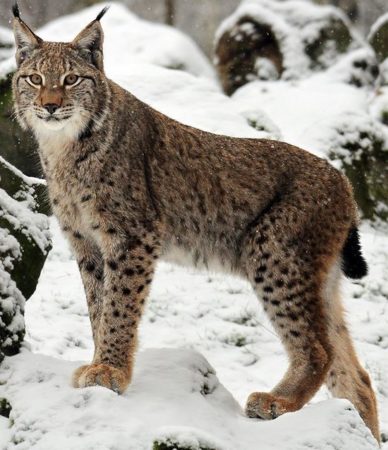A lynx is any of the four species (Canda lynx, Iberian lynx, Eurasian lynx, Bobcat) within the medium-sized wild cat genus Lynx. The name “lynx” originated in Middle English via Latin from the Greek word λύγξ, derived from the Indo-European root leuk- (“light, brightness”) in reference to the luminescence of its reflective eyes.
Two other cats that are sometimes called lynxes, the caracal (desert lynx) and the jungle cat (jungle lynx), are not members of the genus Lynx.
Scientific classification:
| Kingdom: | Animalia |
| Phylum: | Chordata |
| Class: | Mammalia |
| Order: | Carnivora |
| Suborder: | Feliformia |
| Family: | Felidae |
| Subfamily: | Felinae |
| Genus: | Lynx |
Appearance:
Lynx have a short tail, characteristic tufts of black hair on the tips of their ears, large, padded paws for walking on snow and long whiskers on the face. Under their neck, they have a ruff which has black bars resembling a bow tie although this is often not visible.
Body colour varies from medium brown to goldish to beige-white, and is occasionally marked with dark brown spots, especially on the limbs. All species of lynx have white fur on their chests, bellies and on the insides of their legs, fur which is an extension of the chest and belly fur. The lynx’s colouring, fur length and paw size vary according to the climate in their range. In the Southwestern United States, they are short-haired, dark in colour and their paws are smaller and less padded. As climates get colder and more northerly, lynx have progressively thicker fur, lighter colour, and their paws are larger and more padded to adapt to the snow. Their paws may be larger than a human hand or foot.
The smallest species are the bobcat and the Canada lynx, while the largest is the Eurasian lynx, with considerable variations within species.
Behavior and diet:
The lynx is usually solitary, although a small group of lynx may travel and hunt together occasionally. Mating takes place in the late winter and once a year the female gives birth to between one and four kittens. The gestation time of the lynx is about 70 days. The young stay with the mother for one more winter, a total of around nine months, before moving out to live on their own as young adults. The lynx creates its den in crevices or under ledges. It feeds on a wide range of animals from white-tailed deer, reindeer, roe deer, small red deer, and chamois, to smaller, more usual prey: snowshoe hares, fish, foxes, sheep, squirrels, mice, turkeys and other birds, and goats. It also eats ptarmigans, voles, and grouse

Source: https://en.wikipedia.org/
